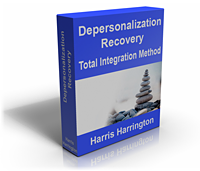Harris Harrington introduces the overview for his DP Cure Tip series, the most complete free explanation of how to cure DP on the internet.
By Harris Harrington
Welcome to the “DP Cure Tip” series
Welcome to the first installment in this series of articles on how to truly overcome and cure Depersonalization Disorder. This series is over an ebook’s worth of the best material on how to rid yourself of the very common dissociative disorder known as Depersonalization Disorder, which afflicts millions of people all over the world.
In my ten-hour program Depersonalization Recovery: Total Integration Method, I show you step-by-step how to become completely DP-free for good.
What is Depersonalization?
There are three primary components of depersonalization that are all equally important. All three of these components fuel the disorder. If you address all three issues of depersonalization, your speed of recovery will increase, and your chances of relapsing will be greatly reduced. As with any psychological problem, resistance that arises from within your self is often the biggest obstacle in getting better. Many times people will resist the information that will help them.
In my program, I go over these three components in detail over the course of 10 hours.
In this article and video series I am going to teach you how to overcome DP following this triangle. Because this topic is complex, I won’t be able to hit every single important point, but will instead outline the general recovery process.
I am also going to go into a discussion of personality traits related to depersonalization and what you can do to overcome DP given that knowledge.
Here is the Depersonalization triangle:
Trauma, Obsession, and Anxiety
Anxiety, Obsession, and Trauma all influence one another and keep depersonalization alive, in the same way that legs on a table keep it upright.
If you address only one or two of the elements of the DP triangle, you may experience some improvement, or interestingly enough, go “in and out” of DP, which I have experienced in the past, and it’s quite bizarre.
Let’s say you’ve managed your anxiety quite a bit, but you obsess quite often about “feeling unreal” and you also haven’t consciously processed the fact that you were neglected as a child and suffered interpersonal trauma in your adolescence.
What could happen is you experience complete feelings of clarity one minute while engaging in some activity, but when you get back home and start focusing inward, you “snap back” into DP. Many people have experienced this. Ultimately it’s a good sign.
Although trauma, obsession, and anxiety are all equally important to the curing of DP, trauma is the most often misunderstood component of the disorder, takes the longest to understand and describe, and is usually the trickiest to resolve. I encourage you to be patient when learning about trauma, and how to process trauma.
In fact, in my Depersonalization Recovery program I talk about trauma the most, not necessarily because it’s more important to address than obsession or anxiety, but because it’s the most complicated.
What does the recovery process of DP look like?
The depersonalization recovery process is often a jagged one. Experiencing days of complete clarity and total recovery, followed by days of complete numbness is common.
Don’t worry.
Be easy on yourself as you read these articles and work through your recovery. Never beat yourself up. You can and will recover.
Start with Anxiety Management
It’s difficult to process past trauma, or overcome obsessions, if you are experiencing extremely high levels of anxiety.
Focus on managing, or eliminating as much of your anxiety first. This is critical.
The DP Cure Tip Series
To address the three components of depersonalization I have created the DP cure tip article series. You will find full articles on not only trauma, anxiety, and obsession, but also on personality and lifestyle issues related to the disorder.
This series of articles is essentially a free ebook’s worth of the best information for people suffering from DP.

